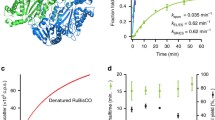Abstract
GroEL is an important model molecular chaperone. Despite being extensively studied, several critical aspects of its functionality are still in dispute due partly to difficulties in obtaining protein samples of consistent purity. Here I describe an easy-to-carry-out purification protocol that can reliably produce highly purified and fully functional GroEL protein in large quantities. The method takes advantage of the remarkable stability of the GroEL tetradecamer in 45% acetone which efficiently extracts and removes tightly bound substrate proteins that cannot be separated from GroEL by the usual chromatographic methods. The efficiency of the purification method can be assessed by the amount of residual tryptophan fluorescence associated with the purified GroEL sample. The functionality of the thus obtained GroEL sample is demonstrated by measuring its ATPase turnover both in the presence and absence of the GroEL model substrate protein α-lactalbumin.
Access this chapter
Tax calculation will be finalised at checkout
Purchases are for personal use only
Similar content being viewed by others
References
Balchin D, Hayer-Hartl M, Hartl FU (2016) In vivo aspects of protein folding and quality control. Science 353:aac4354
Xu Z, Horwich AL, Sigler PB (1997) The crystal structure of the asymmetric GroEL-GroES-(ADP)7 chaperonin complex. Nature 388:741–750
Horwich AL, Farr GW, Fenton WA (2006) GroEL-GroES-mediated protein folding. Chem Rev 106:1917–1930
Lin Z, Rye HS (2006) GroEL-mediated protein folding: making the impossible, possible. Crit Rev Biochem Mol Biol 41:211–239
Hartl FU, Bracher A, Hayer-Hartl M (2011) Molecular chaperones in protein folding and proteostasis. Nature 475:324–332
Taguchi H (2015) Reaction cycle of chaperonin GroEL via symmetric “Football” intermediate. J Mol Biol 427:2912–2918
Todd MJ, Lorimer GH, Thirumalai D (1996) Chaperonin-facilitated protein folding: optimization of rate and yield by an iterative annealing mechanism. Proc Natl Acad Sci U S A 93:4030–4035
Yang D, Ye X, Lorimer GH (2013) Symmetric GroEL:GroES2 complexes are the protein-folding functional form of the chaperonin nanomachine. Proc Natl Acad Sci U S A 110:E4298–E4305
Gruber R, Horovitz A (2016) Allosteric mechanisms in chaperonin machines. Chem Rev 116:6588–6606
Hayer-Hartl M, Bracher A, Hartl FU (2016) The GroEL-GroES chaperonin machine: a nano-cage for protein folding. Trends Biochem Sci 41:62–76
Marchenkov VV, Semisotnov GV (2009) GroEL-assisted protein folding: does it occur within the chaperonin inner cavity? Int J Mol Sci 10:2066–2083
Weissman JS, Hohl CM, Kovalenko O, Kashi Y, Chen S, Braig K, Saibil HR, Fenton WA, Horwich AL (1995) Mechanism of GroEL action: productive release of polypeptide from a sequestered position under GroES. Cell 83:577–587
Walti MA, Clore GM (2018) Disassembly/reassembly strategy for the production of highly pure GroEL, a tetradecameric supramolecular machine, suitable for quantitative NMR, EPR and mutational studies. Protein Expr Purif 142:8–15
Ryabova N, Marchenkov V, Kotova N, Semisotnov G (2014) Chaperonin GroEL reassembly: an effect of protein ligands and solvent composition. Biomol Ther 4:458–473
Voziyan PA, Fisher MT (2000) Chaperonin-assisted folding of glutamine synthetase under nonpermissive conditions: off-pathway aggregation propensity does not determine the co-chaperonin requirement. Protein Sci 9:2405–2412
Todd MJ, Viitanen PV, Lorimer GH (1993) Hydrolysis of adenosine 5′-triphosphate by Escherichia coli GroEL: effects of GroES and potassium ion. Biochemistry 32:8560–8567
Horovitz A, Willison KR (2005) Allosteric regulation of chaperonins. Curr Opin Struct Biol 15:646–651
Grason JP, Gresham JS, Widjaja L, Wehri SC, Lorimer GH (2008) Setting the chaperonin timer: the effects of K+ and substrate protein on ATP hydrolysis. Proc Natl Acad Sci U S A 105:17334–17338
Clark AC, Karon BS, Frieden C (1999) Cooperative effects of potassium, magnesium, and magnesium-ADP on the release of Escherichia coli dihydrofolate reductase from the chaperonin GroEL. Protein Sci 8:2166–2176
Laughlin LT, Reed GH (1997) The monovalent cation requirement of rabbit muscle pyruvate kinase is eliminated by substitution of lysine for glutamate 117. Arch Biochem Biophys 348:262–267
Okazaki A, Ikura T, Nikaido K, Kuwajima K (1994) The chaperonin GroEL does not recognize apo-alpha-lactalbumin in the molten globule state. Nat Struct Biol 1:439–446
Murai N, Taguchi H, Yoshida M (1995) Kinetic analysis of interactions between GroEL and reduced alpha-lactalbumin. Effect of GroES and nucleotides. J Biol Chem 270:19957–19963
Author information
Authors and Affiliations
Corresponding author
Editor information
Editors and Affiliations
Rights and permissions
Copyright information
© 2022 Springer Science+Business Media, LLC, part of Springer Nature
About this protocol
Cite this protocol
Ye, X. (2022). Purification and Handling of the Chaperonin GroEL. In: Muñoz, V. (eds) Protein Folding. Methods in Molecular Biology, vol 2376. Humana, New York, NY. https://doi.org/10.1007/978-1-0716-1716-8_4
Download citation
DOI: https://doi.org/10.1007/978-1-0716-1716-8_4
Published:
Publisher Name: Humana, New York, NY
Print ISBN: 978-1-0716-1715-1
Online ISBN: 978-1-0716-1716-8
eBook Packages: Springer Protocols




